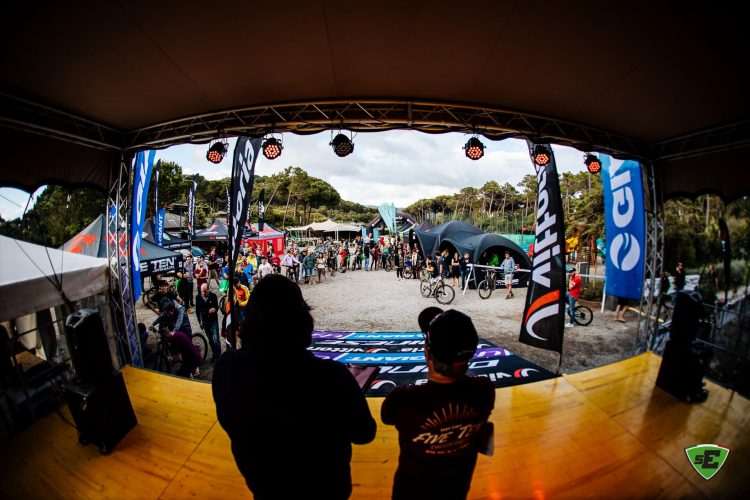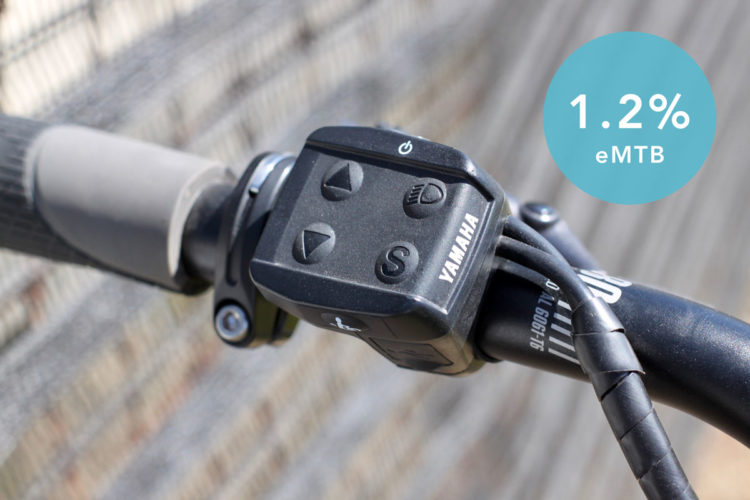While the debate broils hot in the US over e-bike access to trails and to the overall cycling market, sales and representation in the EU continue to grow rapidly. Brands like Fox are seeing 35% of their OEM (direct to producer) sales across Europe go to e-bike models, and those numbers are growing steadily every quarter. In France, e-bike sales increased by 50% in 2017, while Italy saw a 25% increase of electric-assisted sales throughout the peninsula.
The 2018 Eurobike floors were carpeted with e-bikes from wall to wall. Brands fought hard to get their latest electric offerings ready for the show, occasionally at the expense of analog bike models. This year’s Eurobike theme was aimed at enhanced mobility and transportation alternatives, and batteries were decidedly a means toward those ends.

Across the Atlantic, the US and Canada have cooked up an eMTB debate nearly as rich as those surrounding school uniforms and pet-leash laws. Mounting electric motors to mountain bikes has created stalwart cultural and political camps for and against the burgeoning genre. With heated arguments over trail access and cultural ideologies around “laziness” and what the pure sport should be, brands as large as Trek are keeping their e-bike offerings exclusively in the EU market, for now.
This disparity between North America and Europe, arguably the top two MTB-loving continents, makes me wonder why have these user groups and markets are approaching the e-bike in such different ways.
In Europe, it’s not only e-bike sales that are on the rise; participation in e-bike race categories appears to be growing, and e-bike rentals and demos take the main stage at cycling events across the EU. I had a chance to chat with a few anonymous industry professionals and lifelong cyclists from the US and the EU to unpack their thoughts on why there is such a disparate response to the “new bike on the block.” My hope is that with pure anonymity these folks can share a snapshot of why the bikes are so distinctly embraced or rejected.
 In
In
Why do you think cyclists in the EU embrace e-bikes while many in the US oppose or dislike them?
Europeans embrace bicycles
I received a handful of responses to the above question that all centered around a unique cultural ethos toward cycling in the EU that doesn’t exist in the US. One where commuting by bike, and being a cyclist is not only normative but is a respected means of transportation.
One longtime European cyclist I spoke with had a practical urban-environment view of the continental difference of opinion. “In Europe, the bike is more a way to commute and get around without the car, and older folks who are not fit enough want to use an electrical system. For some road and mountain cyclists, this simply carries over [into recreational use].”
A second avid mountain biker replied, “Probably in Europe we have a more widespread and deep cycling culture than in the United States. There is a generally widespread enthusiasm. This is to say that there are a lot more people that love the bike (in a general sense I am not speaking only of extreme enthusiasts.) But many do not like to struggle, so they see the solution in the e-bike. In the USA probably that passionate part exists, but at the same time the lazy user is missing.”
An Italian friend of mine who teaches yoga to cyclists mentioned that “I would say it’s because in the EU, e-bikes are seen more as an incentive to tourism for those who are not in shape. Also, in Europe there is a much older population overall.”
An Italian bike shop owner who lives near me also mentioned the positive tourism attributes of e-bikes, stating “it’s fun, it requires less training, people can go anywhere, but with a bike”.
This response from a lifelong rider in the US is fairly in line with the others, with the added emphasis on social class perceptions of cyclists in the US. “Disregarding the elephant in the room, ie pedal bikes are more popular in the EU than the US, I think it boils down similarly. Probably perception. If you ride a bike or take a bus in the US, you are poor. (Generally) that provides poor optics for any company trying to sell e-bikes as a method of transit. But if there were a Rapha-style branding of an e-bike, for a regular consumer, it could be different. Also, they look clunky”.
A good friend who is Dutch and lives in Portland, Oregon had some insight on how the industry arrived at its current state in the EU. “I see an interest that was sparked by the commuters and then pushed into other markets by the industry. As in, the industry was playing more and more with e-bike options for the road and then created some off-road options just to see if there would be any consumer interest there too. There was, and so the industry jumped on it big time (not unlike the way the industry has been pushing gravel bikes on us).”
Lastly, another former professional dirt rider from the US echoed the above theme, that bikes in the US are toys for fun, while in the EU they are an integral part of urban life. “Because so many more people commute on bikes (and mopeds and by foot) in European cities, and [bikes] are so ingrained in the culture. They’re more of an actual vehicle used for practical purposes, AND for fun, AND for competitive sport. So bikes, in general, are more widely accepted, so the transition to e-bikes is easier. Whereas in the US they’re mostly a recreational piece of sports equipment. A bike [in the US] is a ‘lifestyle’ choice. ‘I’m going into the woods with my friends and my MTB.’ It’s just more of a purist mentality. I don’t think anyone cares about e-bikes in US cities. It’s just [that] putting them on busy popular trails, with slower riders, is when the actual issue arises”.
Trail access differences

A second theme from responses to this question centered around the differences between trail and riding types, and trail access between the two continents.
I spoke with a professional mountain bike racer from the US, now living in the EU, who formulated a response in two parts. “1. There is generally less trail user regulation here in Europe. Pedestrians, equestrians, and bikes all share most trails here. Reduced regulation and reduced conflict leave the culture more open to any sort of recreational activity. 2. There are far fewer loop trails, ridge trails, or up trails in the European mountain bike scene. Generally, we ride up a very, very steep gravel roads to get to the singletrack descent. We don’t have well-maintained and enjoyable trails to climb. If the goal is to enjoy yourself, and the enjoyment comes on the descent, why not remove some of the burdens of the strenuous climb?”
Another avid shredder from the US who lives in Italy had this to add, “I’d say it’s mostly because of the type of riding most people do in Europe. In the states, most rides on the MTB are at trail centers (In the US I used to ride almost exclusively in state parks with trails built by NEMBA), and I think most people drive there, unload their bikes and ride around. In Europe, most rides are ‘tours’ Considering that there are fewer dedicated parks or trail centers, but rather more long-distance multi-use trails [and] cycleways through open-access land, you can link up trails to get to some amazing places and ride some epic terrain, but this often involves riding a lot more distance to the same amount of quality singletrack.”


Still another group of folks I chatted with took the opportunity to trash talk e-bikes, but I will let them save those responses for the comments section, as I am not looking to fuel that fire herein. One European industry professional I spoke with mentioned his own personal reasons for not switching to the e-bike just yet. “I’m not ready. I like hurting myself on the bike, and although I’m probably limiting the things I can do trail-wise… I’m just not ready for a whole new sport that is advancing so fast that my investment is out of date in a year.” This particular friend has ridden many e-bikes, but says that for his own personal bike he will wait until the new and shiny glare fades a bit before he purchases a motorized version.

Your thoughts, please
In summation, Europeans generally have a different cultural respect and acceptance of cycling that carries over into the sport, and bikes are more directly integrated into their lives. The types of trails available on both continents vary drastically, and this may have some effect on how people chose the bikes they buy. These two response categories paint a decent picture of the e-bike love story, but I am curious if there are other important elements to consider. Please share your thoughts and ideas on the e-bike trend in the US and Europe, and why the bikes are being received in such divergent ways.
Comment away!




















